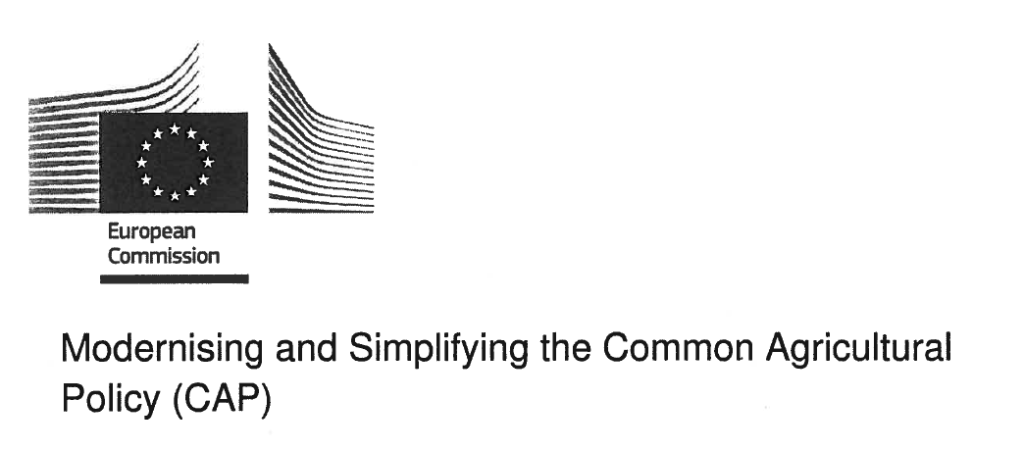Updated 01/02/2017 and 02/02/2017
ARC2020 has obtained an advance, as yet unpublished copy of the European Commission’s upcoming CAP consultation questions. A distinct lack of big picture European or even agri-food system thinking is revealed. Opting in the main for a checklist format, the 20 page document takes an approach that discourages creative thinking around common European visions and notions of solidarity. While the individual questions could be worse, the approach itself could be so much better (NEW 18.45 CET 01/02/2017 download all the CAP Consultation questions )
(NEW 10.00 CET 02/02/2017)
Live Phil Hogan announces consultation on the Future of EU Food & Farming: Modernising & Simplifying the CAP from 12.00 CET”

The 20 page document, called “Monitoring and Simplifying the Common Agricultural Policy” is divided into five parts. A) About You B) Agriculture, Rural Areas and the CAP Today C) Objective and Governance D) Agriculture, Rural Areas and the CAP Tomorrow and finally E) Modernisation and Simplification.
In each of the main four sections (B-E above) the options are for levels of agreement and disagreement – typically from largely agree to largely disagree – and for choosing a limited order of preference – typically a top three or top five. These are the main methodologies.
Within these, many of the questions are relevant: the main areas of farmer income, environment goods and rural development are certainly covered. But, for the most part, covered is all they are.
Section B) Agriculture, Rural Areas and the CAP Today
Section B) begins with challenges for EU agriculture and rural areas (Q.1); best policy tools to meet challenges (Q2, Q.3); farmer contributions to society (Q.4); farmer costs, investments and income (Q.5); environmental challenges (Q.6, Q.7); barriers to farming (Q.8); drivers of innovation (including in forestry) (Q.9); efficacy of farm advisory service (Q.10); recent reforms and policy coherence – success and obstacles (Q.11, Q.12); CAP burdens/complexity (Q.13).
Of these, Q.1 Lists six challenges, from which you must choose but three as being the most important: fair standard of living for farmers; adaptation to consumer/societal trends; pressures on the environment and natural resources; climate change (mitigation and adaptation); lack of jobs and growth in rural areas; uneven territorial development throughout the EU.
Current tools to meet challenges – Q.2 – is an especially long list to select from: decoupled payments; coupled support; rural development environmental and climate actions; rural development investments in physical and human capital; trade measures; market safety nets; risk management schemes; support for integration into producer organisations; regulatory approaches (such as standards and rules): you will get to choose five only.
All except two of these first 13 questions are answered as checklists: form-fillers select a small number of answers each time. Questions 12 (below) and 13 (on burdens and complexities of CAP) are the only two to allow for more, in this case for 1500 characters of content.

Section C) Objectives and Governance
Section C) works from the template of the 10 EU Commission priorities and states “most” “are relevant” to CAP. This is welcome, but, again, checklists are the options provided.
Q.14 asks the form-filler to rank a top three of pre-selected relevant priorities: investment/growth/employment; connectivity; climate change (mitigation and adaptation); the single market, world trade and migration. This latter option – “help address challenges related to migration” – is a new, timely departure from the key considerations of the previous CAP, considering the humanitarian refugee crises engulfing Europe and beyond.
Unfortunately, this is the only reference to this huge issue. Indeed the very next question, Q.15, asked what are the “most important objectives of CAP”, lists not six but nine options developed from the previous questions, but somehow excludes any options related to the previous migrant question. How does a “priority” not translate into an “objective”?
Compare this to the priorities of the European Rural Parliament, which as its second listed theme states “Welcoming and integrating refugees and economic migrants within rural communities”.
At least Q.16 allows for 1500 characters to add “other objectives”.
Q.17 asks a broad question – “it makes sense to have a common agricultural policy because” – but then goes on to provide yet another list with preferences. Common rules, common objectives, efficiency, cohesion and solidarity, better international positioning, a common framework for mutual learning. These are all thoughtful areas for consideration – but for box ticking ? What about overlaps, synergies and incongruities?
Q.18 asks at which level certain key areas should be dealt with (areas related to income/markets/jobs/competitiveness; price/quality of food; environmental considerations; rural and balanced EU development) – the EU, national or regional/local levels (yes, its a box tick).
Section D) – Agriculture, Rural Areas and the CAP Tomorrow
The penultimate section, section D – Agriculture, Rural Areas and the CAP Tomorrow – begins with Q.19, which asks for opinions (from largely agree to largely disagree) on statements about the following: the need for direct income support, effect of other (non-agricultural) policy impacts on incomes; agricultural policy should deliver more environmental impacts; supporting innovation and restructuring with targeted investments; and improving farmer’s position in the value chains (including in relation to unfair trading practices).
Q.20 presents a list for improving competitiveness, while Q.21 (below) asks “which of the following criteria is most relevant for direct support,” listing 10 quite interesting options, allowing five to be selected.

Q.22 asks about improving export performance (only three options allowed!) while Q.23 asks a huge question – “Considering consumer and wider societal demands, where can the linkage between CAP and standards be improved?” Some interesting, if isolated options, as you can see below. And yes there are only three to select from these nine – how to choose?

Q.24 deals with the ‘burden’ of higher standards – who should carry them? Voluntary (with financial incentives); mandatory (with increased farmer supports); “farmers have to respect stricter rules without specific financial support”; awareness campaigns to encourage consumer to pay more.
Q.25 asks to prioritise which “environmental protection objectives” CAP needs to do more about (choice of three), while while Q.26 and Q.27 do so for climate change and forestry options. Q.28 gives a long list of rural development options, inspired by Cork 2.0, and allows for five to be selected. The section ends with questions on young farmers and supporting innovation, again to select three from.
Read: All ARC2020’s articles on CAP
Section E) Modernisation and Simplification
Q.31 Simplification is answered with a “largely agree” to “largely disagree” spectrum, and it asks: reduce overlaps between rural development and CAP measures; reduced inspections through better use of data and tech; more use of E-government; lump sum approaches; more environmental choices.
There is also a 1500 character option for adding thoughts on simplification, while that is also what’s available for modernisation.
Finally, an option is presented to upload “a concise document (maximum five pages) such as a position paper.” Considering how checklisty the process is, this is an option many organisations may well take up.
Analysis
The core problem with this new consultation is that there are very few ‘how to’s’ and plenty of ‘which do you prefer’s’. We have a menu of individualised options, disconnected from addressing questions with an agri-food system perspective. This approach – an a la carte menu of minor, obvious options – encourages silo thinking and is wholly unambitious. Why not ask, for example:
i) how to insure fair trading conditions and fair income to farmers?
ii) how can the agri-food sectors meet societal expectations and demands (in environment, food quality, rural livelihoods and landscapes)?
iii) What is the added-value of a specifically common and specifically European agri-food policy? What make sense through the CAP? What’s the added-value of and for the EU through the CAP? What should the EU authority level do, and how should the national level complement this?
2017’s CAP process thus displays none of the ambition of the previous reform, which began in April 2010. This was a genuinely broad-based initiative, spearheaded by then Commissioner Daclan Ciolos. Whatever about the disappointing conclusion of the process, and the lack of real and deep reform, the process itself was at least inclusive and displayed a willingness to grapple with fundamentals. In this, it was a departure from earlier previous CAP reforms, in 1996 and 2003, which were more like closed shops for the sector.
In 2010, all sector stakeholders and the general public were invited to answer four big picture questions:
- Why do we need a European Common Agricultural Policy;
- What do citizens expect from agriculture;
- Why reform the CAP and how do we make it meet societies expectations?
- Which tools for tomorrow’s CAP?
5700 responses were received, far more than was expected.
For all the talk of simplification by the current Commissioner, the final section, Section E, seems like an after thought. The questions will not address real challenges of simplification and modernisation. As the recent mapping and analysis of the CAP implementation carried out by DG Agri showed, a lot can be done at national and payment agency levels to simplify the CAP. Simplification needs both the Commission and the Member States to commit to it for it to work in a fair and coherent way. Regarding modernisation of the CAP, this was an opportunity lost – the food system dimension of is not addressed at all.
Its exasperating to know that ARC2020’s Communication from 2010 is still both valid and current. And that our far more recent debate – the #AFTERCAP debate, where we brought stakeholders from a range of perspectives to debate CAP – allowed for more thoughtful and connected considerations that what’s on display in this set of Commission questions.
We will, however, in the coming weeks and months, work hard to develop our own considerations on CAP, to give voice to stakeholders who want to engage in the process, and to do what we can to improve how European farming, food and the rural interconnect.
Historical
ARC2020’s first press release on the CAP reform (July 2010)
ARC2020 Statement of Principles (July 2010)




